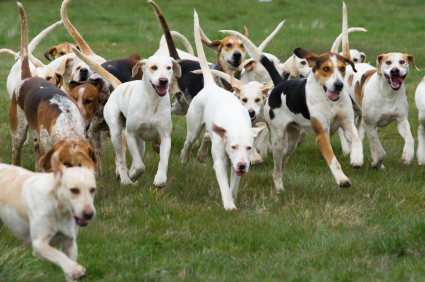The typical fox hunting season for the northern hemisphere is between the months of November and April. A typical fox hunt generally occurs as such: After deciding on a designated starting location, the leader of the hunt, or “Field Master”, will let loose their hounds into a wooded area that may contain a fox in hiding. This is called “casting”. Once the hounds have been cast, they will continue to search for their target, or “quarry”, until they have caught the scent. The hounds, which are of a particular breed specifically bred, raised, and trained for the purpose of hunting, will “cry” or howl loudly to alert the huntsmen of a quarry in chase. A single pack can consist of more than 30 hounds.
These hounds will follow the scent of the prey, while the hunting party follows on horseback. The hunting party will follow the hounds until they either catch the quarry, or until the scent is lost. If the scent is lost, the hounds will be given a few moments to either relocate the scent, or follow a new scent. Typically, during a hunt, when a fox becomes exhausted by the chase, it will “go to ground”, meaning it will attempt to hide underground. In most cases, it is at this point that the hounds will catch up to the quarry and, under the instruction of the huntsman, kill the fox. It is sometime common practice to enter the hunting grounds the evening prior, and block all covers for the fox, so that it has nowhere to hide. On rare occasions, after the fox has been cornered, the fox is re-released to continue the hunt. However, this is considered in poor taste by hunters, and frowned upon by the community.
Here is a Video showing a typical fox hunt.

